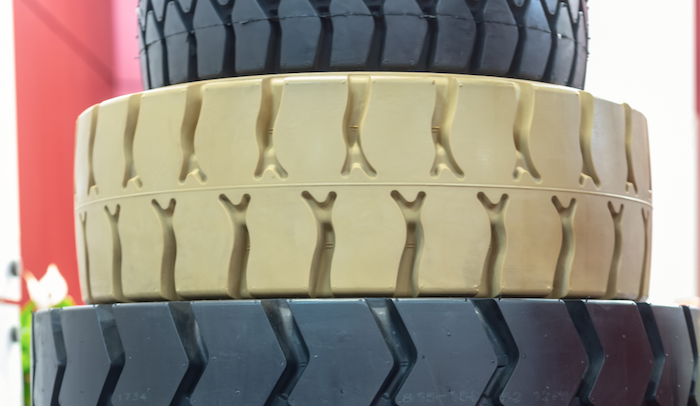
A recently developed solution using graphene nanotubes effectively solves the issue of producing non-marking anti-static solid tires to ensure safe operation of industrial trucks, forklifts and trolleys by avoiding accumulation of static electricity. Graphene nanotubes are the only cost-effective solution to comply with EN and ISO Electrostatic discharge (ESD) standards without impacting the durability of tires.
Non-marking solid tires with conductive or anti-static properties must be used in a number of applications to prevent electrostatic discharge. Potentially explosive areas have always been strictly controlled by the ATEX regulations and EN 1755 standard, but now these regulations are also applied to ignition risk in a much wider range of industries, such as the chemical, pharmaceutical, food & drink, waste, and cosmetics industries, the military, manufacturing, logistics and others. Now, manufacturers must comply with the requirements of a low surface resistance of a maximum of 10^9 Ω for the outer material of castors and wheels of all heavy equipment used in the factory.
This encourages the industry to look for the most suitable solution to comply with the new safety requirements, while retaining the non-marking properties of the tire. Existing solutions demonstrate non-stable conductive properties due to a mechanism that is based on nonreactive polymer migrating to the rubber surface. Moreover, the high loading rate of conductive plasticizer required to achieve anti-static properties leads to the degradation of mechanical properties of rubber. These drawbacks result in a negative effect on the performance and the shelf life of the tire.
In contrast, TUBALL graphene nanotubes, produced by OCSiAl, guarantee required permanent anti-static properties in full compliance with the ATEX regulations and EN and ISO ESD standards, but at the same time enable coloration and non-marking properties with maintained mechanical and elastic performance.
Being applied to an NR/BR blend of rubber during a standard manufacturing process via a brand new, industry-friendly TUBALL MATRIX concentrate, graphene nanotubes form a permanent, stable conductive 3D network inside the material matrix at an ultra-low loading rate of 0.22% wt.
“This is yet another development with graphene nanotubes that challenges preconceptions of advanced technologies: it is easy to use with standard processing equipment and does not lead to significant cost increase,” said Ekaterina Gorbunova, Vice-President for Elastomers at OCSiAl. “Graphene nanotubes solve the issue of the accumulation of static electricity in non-marking tires while being a cost-effective solution with no required additional equipment or changes in the manufacturing process of the tire rubber compound.”
For high-performance solid tires, OCSiAl has also developed another customized solution that significantly improves the mechanical performance of NR- or NR/BR-based formulations containing mineral fillers.
Ensuring a long service life and stable conductive properties, graphene nanotubes are widely used in a variety of rubber products, such as motorcycle tires, conveyor belts, electronic and cable elements, automotive and oil & gas components, printing and industrial rollers.
Read more details on the new technology at tuball.com.
